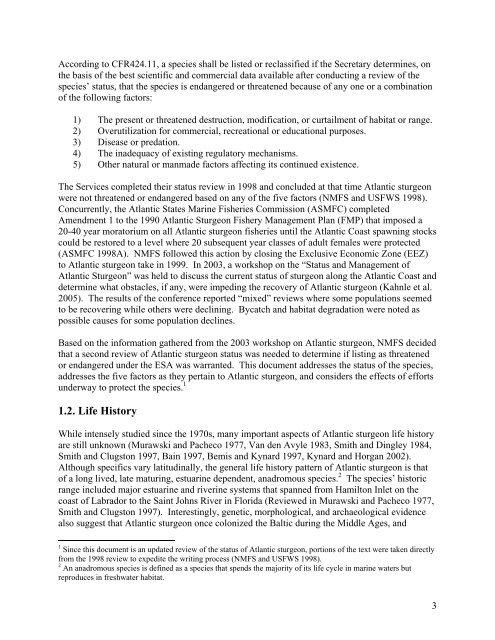2007 Status Review of Atlantic sturgeon - National Marine Fisheries ...
2007 Status Review of Atlantic sturgeon - National Marine Fisheries ...
2007 Status Review of Atlantic sturgeon - National Marine Fisheries ...
You also want an ePaper? Increase the reach of your titles
YUMPU automatically turns print PDFs into web optimized ePapers that Google loves.
According to CFR424.11, a species shall be listed or reclassified if the Secretary determines, on<br />
the basis <strong>of</strong> the best scientific and commercial data available after conducting a review <strong>of</strong> the<br />
species’ status, that the species is endangered or threatened because <strong>of</strong> any one or a combination<br />
<strong>of</strong> the following factors:<br />
1) The present or threatened destruction, modification, or curtailment <strong>of</strong> habitat or range.<br />
2) Overutilization for commercial, recreational or educational purposes.<br />
3) Disease or predation.<br />
4) The inadequacy <strong>of</strong> existing regulatory mechanisms.<br />
5) Other natural or manmade factors affecting its continued existence.<br />
The Services completed their status review in 1998 and concluded at that time <strong>Atlantic</strong> <strong>sturgeon</strong><br />
were not threatened or endangered based on any <strong>of</strong> the five factors (NMFS and USFWS 1998).<br />
Concurrently, the <strong>Atlantic</strong> States <strong>Marine</strong> <strong>Fisheries</strong> Commission (ASMFC) completed<br />
Amendment 1 to the 1990 <strong>Atlantic</strong> Sturgeon Fishery Management Plan (FMP) that imposed a<br />
20-40 year moratorium on all <strong>Atlantic</strong> <strong>sturgeon</strong> fisheries until the <strong>Atlantic</strong> Coast spawning stocks<br />
could be restored to a level where 20 subsequent year classes <strong>of</strong> adult females were protected<br />
(ASMFC 1998A). NMFS followed this action by closing the Exclusive Economic Zone (EEZ)<br />
to <strong>Atlantic</strong> <strong>sturgeon</strong> take in 1999. In 2003, a workshop on the “<strong>Status</strong> and Management <strong>of</strong><br />
<strong>Atlantic</strong> Sturgeon” was held to discuss the current status <strong>of</strong> <strong>sturgeon</strong> along the <strong>Atlantic</strong> Coast and<br />
determine what obstacles, if any, were impeding the recovery <strong>of</strong> <strong>Atlantic</strong> <strong>sturgeon</strong> (Kahnle et al.<br />
2005). The results <strong>of</strong> the conference reported “mixed” reviews where some populations seemed<br />
to be recovering while others were declining. Bycatch and habitat degradation were noted as<br />
possible causes for some population declines.<br />
Based on the information gathered from the 2003 workshop on <strong>Atlantic</strong> <strong>sturgeon</strong>, NMFS decided<br />
that a second review <strong>of</strong> <strong>Atlantic</strong> <strong>sturgeon</strong> status was needed to determine if listing as threatened<br />
or endangered under the ESA was warranted. This document addresses the status <strong>of</strong> the species,<br />
addresses the five factors as they pertain to <strong>Atlantic</strong> <strong>sturgeon</strong>, and considers the effects <strong>of</strong> efforts<br />
underway to protect the species. 1<br />
1.2. Life History<br />
While intensely studied since the 1970s, many important aspects <strong>of</strong> <strong>Atlantic</strong> <strong>sturgeon</strong> life history<br />
are still unknown (Murawski and Pacheco 1977, Van den Avyle 1983, Smith and Dingley 1984,<br />
Smith and Clugston 1997, Bain 1997, Bemis and Kynard 1997, Kynard and Horgan 2002).<br />
Although specifics vary latitudinally, the general life history pattern <strong>of</strong> <strong>Atlantic</strong> <strong>sturgeon</strong> is that<br />
<strong>of</strong> a long lived, late maturing, estuarine dependent, anadromous species. 2 The species’ historic<br />
range included major estuarine and riverine systems that spanned from Hamilton Inlet on the<br />
coast <strong>of</strong> Labrador to the Saint Johns River in Florida (<strong>Review</strong>ed in Murawski and Pacheco 1977,<br />
Smith and Clugston 1997). Interestingly, genetic, morphological, and archaeological evidence<br />
also suggest that <strong>Atlantic</strong> <strong>sturgeon</strong> once colonized the Baltic during the Middle Ages, and<br />
1<br />
Since this document is an updated review <strong>of</strong> the status <strong>of</strong> <strong>Atlantic</strong> <strong>sturgeon</strong>, portions <strong>of</strong> the text were taken directly<br />
from the 1998 review to expedite the writing process (NMFS and USFWS 1998).<br />
2<br />
An anadromous species is defined as a species that spends the majority <strong>of</strong> its life cycle in marine waters but<br />
reproduces in freshwater habitat.<br />
3

















